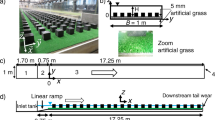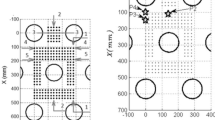Abstract
This paper investigates the relationship between the rainfall and runoff in idealised catchments, either with or without obstacle arrays, using an extensively-validated fully-dynamic shallow water model. This two-dimensional hydrodynamic model allows a direct transformation of the spatially distributed rainfall into the flow hydrograph at the catchment outlet. The model was first verified by reproducing the analytical and experimental results in both one-dimensional and two-dimensional situations. Then, dimensional analyses were exploited in deriving the dimensionless S-curve, which is able to generically depict the relationship between the rainfall and runoff. For a frictionless plane catchment, with or without an obstacle array, the dimensionless S-curve seems to be insensitive to the rainfall intensity, catchment area and slope, especially in the early steep-rising section of the curve. Finally, the model was used to study the hydrological response of an idealised catchment covered with buildings, which were represented as an obstacle array. The influences of the building array size and layout on the catchment response were presented in terms of the dimensionless time at which the catchment outflow reaches 50 % of the equilibrium value.










Similar content being viewed by others
References
Caviedes-Voullième D, García-Navarro P, Murillo J (2012) Influence of mesh structure on 2D full shallow water equations and SCS curve number simulation of rainfall/runoff events. J Hydrol 448–449:39–59
Cea L, Puertas J, Pena L, Garrido M (2008) Hyrdrological forecasting of fast flood events in small catchments with a 2D-SWE model. Proceedings of the World Water Congress, Montpellier
Cea L, Garrido M, Puertas J (2010) Experimental validation of two-dimensional depth-averaged models for forecasting rainfall-runoff from precipitation data in urban areas. J Hydrol 382:88–102
Chan Y (2012) Rainfall-runoff processes in urban environments. MEng thesis. University of Cambridge, UK, p 49
Costabile P, Costanzo C, Macchione F (2012) Comparative analysis of overland flow models using finite volume schemes. J Hydroinformat 14(1):122–135
Costabile P, Costanzo C, Macchione F (2013) A storm event watershed model for surface runoff based on 2D fully dynamic wave equations. Hydrol Proces 27:554–569
Di Giammarco P, Todini E, Lamberti P (1996) A conservative finite elements approach to overland flow: the control volume finite element formulation. J Hydrol 175(1–4):267–291
Feng K, Molz GJ (1997) A 2-D diffusion-based, wetland flow model. J Hydrol 196:230–250
Gottardi G, Venutelli M (2008) An accurate time integration method for simplified overland flow models. Adv Water Resour 31:173–180
Govindaraju RS, Jones SE, Kavas ML (1988) On the diffusion wave model for overland flow: 1. Solution for steep slopes. Water Resour Res 24(5):734–744
Govindaraju RS, Kavvas ML, Jones SE (1990) Approximate analytical solutions for overland flows. Water Resour Res 26(12):2903–2912
Kazezyilmaz-Alhan C, Medina MA (2007) Kinematic and diffusion waves: analytical and numerical solutions to overland and channel flow. J hydraul Eng 133(2):217–228
Liang D, Xia J, Falconer RA, Zhang J (2014) Study on tidal resonance in Severn Estuary and Bristol Channel. Coast Eng J 56(1):1–18 (Article no 1450002)
Liang D, Falconer RA, Lin B (2006) Comparison between TVD-MacCormack and ADI-type solvers of the shallow water equations. Adv Water Resour 29(12):1833–1845
Liang D, Falconer RA, Lin B (2007) Simulation of rapidly varying flow using an efficient TVD-MacCormack scheme. Int J Numer Meth Fluids 53:811–826
Liang D, Wang X, Falconer RA, Bockelmann-Evans BN (2010) Solving the depth-integrated solute transport equation with a TVD-MacCormack scheme. Environ Model Softw 25(12):1619–1629
Liang D, Borthwick AGL, Romer-Lee JK (2012) Run-up of solitary waves on twin conical islands using a boussinesq model 134(1). J Offshore Mech Arct Eng 134(1):1–9 (Article no. 011102)
Moramarco T, Singh VP (2002) Accuracy of kinematic wave and diffusion wave for spatial-varying rainfall excess over a plane. Hydrol Process 16:3419–3435
Morgali JR, Linsley RK (1965) Computer analysis of overland flow. J Hydraul Div ASCE 91(3):81–100
Mügler C, Planchon O, Patin J, Weill S, Silvera N, Richard P, Mouche E (2011) Comparison of roughness models to simulate overland flow and tracer transport experiments under simulated rainfall at plot scale. J Hydrol 402:25–40
Schubert JE, Sanders BF (2012) Building treatments for urban flood inundation models and implications for predictive skill and modelling efficiency. Adv Water Resour 41:49–64
Simons F, Busse T, Hou J, Özgen I, Hinkelmann R (2014) A model for overland flow and associated processes within the hydroinformatics modelling system. J Hydroinformat 16(2):375–391
Thompson SE, Katul GG, Porporato A (2010) Role of microtopography in rainfall-runoff partitioning: An analysis using idealized geometry. Water Resources Research. doi:10.1029/2009WR008835 (Article no W07520)
Tsai WC (2003) Applicability of kinematic, noninertia, and quasi-steady dynamic wave models to unsteady flow routing. J Hydraul Eng 129(8):613–627
Unami K, Kawachi T, Kranjac-Berisavljevic G, Abagale FK, Maeda S, Takeuchi J (2009) Case Study: hydraulic modeling of runoff processes in Ghanaian inland valleys. J Hydraul Eng 135(7):539–553
Woolhiser DA, Liggett JA (1967) Unsteady, one-dimensional flow over a plane—the rising hydrograph. Water Resour Res 3(3):753–771
Yeh G-T, Shih D-S, Cheng J-RC (2011) An integrated media, integrated processes watershed model. Comput Fluids 45(1):2–13
Zhang W, Cundy TW (1989) Modeling of two-dimensional overland flow. Water Resour Res 25(9):2019–2035
Acknowledgments
Dr. Liang and Prof. Hinkelmann thank the Alexander von Humboldt Foundation for providing the opportunity for their collaboration. Dr. Liang thanks the financial support by the Royal Academy of Engineering (NRCP/1415/97 and ISS1516\8\34). Prof. Xiao and Dr. Chen thank the financial support by the National Natural Science Foundation of China (51450110079) and Chinese Academy of Engineering (2015-ZD-07-04-01).
Author information
Authors and Affiliations
Corresponding author
Rights and permissions
About this article
Cite this article
Liang, D., Özgen, I., Hinkelmann, R. et al. Shallow water simulation of overland flows in idealised catchments. Environ Earth Sci 74, 7307–7318 (2015). https://doi.org/10.1007/s12665-015-4744-5
Received:
Accepted:
Published:
Issue Date:
DOI: https://doi.org/10.1007/s12665-015-4744-5




